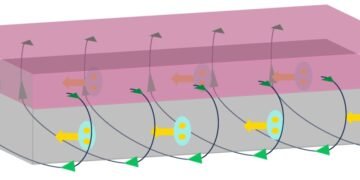Many natural surfaces can rapidly shed water droplets due to their water-repellent functionality. In 1945, scientists Cassie and Baxter linked the water-repellent function of natural surfaces to their surface textures. The use of low solid fraction textures (denoted Φs) is therefore a key principle to design water-repellent surfaces. In this work, Lin Wang and a team of scientists in materials science, biomedical engineering and mechanical engineering at the Pennsylvania State University, U.S. reduced the contact time of bouncing droplets on high solid fraction surfaces (i.e. Φs ~ 0.25 to 0.65) by reducing the surface texture size to the nanoscale. They showed how high solid fraction surfaces with a texture size below 100 nanometers could reduce the contact time of bouncing droplets by approximately 2.6 milliseconds (ms) compared to a texture size above 300 nm. The texture and size-dependent contact time reduction observed on solid surfaces is a first-in-study outcome relative to existing theories on surface wettability. Wang et al. credited the reduction in droplet contact on nanoscale surfaces to the dominant three-phase contact line tension. Based on pressure stability experiments, the team further showed how surface solid fractions were bioinspired by insects that can withstand the impact of raindrops. The results are now published on Science Advances.
Nanoscale surfaces have diverse roles in biological organisms with importance for insect survival, examples include anti-reflection properties of moth eyes, antifogging properties of mosquitoes, self-cleaning techniques of cicada and anti-biofouling of dragonfly. The rapid detachment of raindrops on flying insects is also critical for their survival. For instance, the impact duration of raindrops on mosquitoes approximated 0.5 to 10 ms; a time frame of combined active and passive droplet shedding mechanisms. Plants and butterfly wings can also maintain microscale patterns to break the impact of droplets into smaller pieces to reduce droplet contact time. However, materials scientists must still understand how the high solid fraction and nanoscale textures of water-repellent insect surfaces can cause rapid detachment of raindrops on impact. To explore texture size effects and liquid-solid interactions, Wang et al. engineered a series of bioinspired, insect-like textured surfaces, coated them with a silane monolayer to induce surface hydrophobicity (water-hating nature) and conducted a series of experiments.
Measuring the contact time of bouncing droplets on textured surfaces
During the experiments, the team maintained the Cassie-Baxter state (heterogenous surface wetting) with the test liquid droplets and compared the contact time of bouncing water droplets on textured surfaces. Surfaces with a texture size smaller than 300 nm showed decreased contact time for bouncing droplets. The texture size-dependent reduction of droplet contact on solid surfaces was a first-in-study compared to existing surface wetting theories.
In theory, the contact time can be predicted relative to the density and surface tension of water. When a liquid droplet impacted a textured surface, it spread to a maximum diameter and retracted from the surface much like a ‘liquid spring.” On low solid fraction textured surfaces, the liquid-air interfacial tension of the droplet dominated the spring constant of the liquid spring. Meanwhile any contributions from liquid-solid interactions could be ignored. However, scientists could not ignore liquid-solid interactions on high solid fraction textured surfaces where Φs equalled 0.44, due to additional energy resulting from the formation of three-phase contact lines beneath the droplets to influence their bouncing energies. For this, Wang et al. considered the three-phase contact line tension (τ), first introduced by Gibbs in the 1870s, where the experimental measurements of τ depended on the specific system under investigation.


































